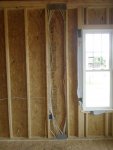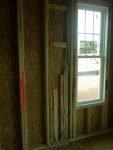Bob Sisson
Member
- Location
- Boyds, MD
I see what I consider "problem" bundling all the time during new Home construction. The local electrician or AHJ routinely overrules me saying "no problem." In this last instance the insulation was going to be FOAM, not fiberglass so no air circulation. So these cables were going to be encased in FOAM insulation for 10' (1 floor) and half of them for ANOTHER 10' as they continued into the attic....
On the right are 2x12s, 4x14s, 1X10. On the Left are 5 x 14's, 1X12 and and extra 14 for the outlet
I flagged it, the the AHJ and local electrician said it was OK...
My question is: Who is right, are these "Bundles" and thus need to be derated or spread out more?

On the right are 2x12s, 4x14s, 1X10. On the Left are 5 x 14's, 1X12 and and extra 14 for the outlet
I flagged it, the the AHJ and local electrician said it was OK...
My question is: Who is right, are these "Bundles" and thus need to be derated or spread out more?


